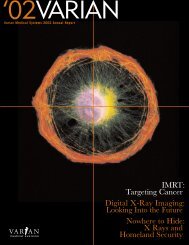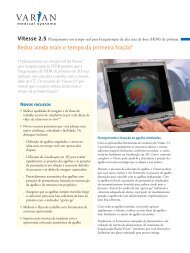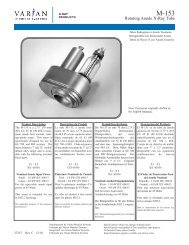Varian Linatron High-Energy X-ray Applications 2007
Varian Linatron High-Energy X-ray Applications 2007
Varian Linatron High-Energy X-ray Applications 2007
Create successful ePaper yourself
Turn your PDF publications into a flip-book with our unique Google optimized e-Paper software.
Comparing the exposure and density for the particular<br />
application with standard exposures and densities from an<br />
exposure curve or other reference is another way to<br />
determine blocking effectiveness. If a shorter exposure of<br />
the material corresponds to a higher film density, when<br />
compared with other well-blocked exposures, it is very<br />
likely that scatter has contributed to the exposure.<br />
Lead Intensifying Screens as Filters. The thin metal foil<br />
(usually lead) intensifying screens that are placed in front<br />
and back of the film to intensify the primary beam and<br />
shorten the exposure also function as filters to reduce the<br />
amount of scattered radiation that reaches the film. Much<br />
of the scatter can be stopped by the lead screen since the<br />
average energy of the scattered radiation is lower than the<br />
energy of the primary beam.<br />
Example<br />
At 10 MeV, a front lead foil 0.01 inch (0.25 mm) thick<br />
will reduce scatter reaching the film by 35% when<br />
exposing about 5 HVLs of low-Z material.<br />
It is customary to select the front lead screen thickness so<br />
the screen provides both intensification and filtration.<br />
However, this practice may not always give the optimum<br />
image quality results. The thickness of a front lead screen<br />
should never exceed 0.050 inch (1.3 mm). The<br />
radiographer should consider using a composite filter<br />
placed in front of the film holder if additional filtration is<br />
needed beyond that. The quality of the image should be<br />
the basis for deciding whether filtration is effective. Some<br />
radiographers eliminate backscatter by using external<br />
(back) lead shielding rather than using lead foils.<br />
Filters. Absorbing plates or assemblies placed between the<br />
object and the film holder may be necessary to achieve the<br />
best image quality when:<br />
• The object shape, position, or composition produces<br />
extensive scatter.<br />
• Large object thickness produces scatter greatly in excess<br />
of the primary radiation.<br />
• The object is smaller than the radiation field.<br />
• Large thickness differences exist in the object.<br />
• <strong>High</strong>-speed photoelectrons produced in the object may<br />
reach the film holder.<br />
page 15<br />
In most cases, the front metal foil intensifying screen will<br />
provide enough filtration to obtain good image quality.<br />
However, in applications (e.g., assembly radiography),<br />
where image sharpness is paramount and a number of the<br />
conditions listed above may exist, an object-film filter of<br />
suitable design is recommended. The filter should be<br />
placed as close behind the object as practicable. The ideal<br />
filter can be layers of high-Z material (such as lead) closer<br />
to the source with subsequent layers of decreasing Z<br />
materials since the filter itself may be a source of scatter. In<br />
some applications a simple filter of lead and brass may be<br />
sufficient.<br />
Screen choices depend on the application, the details of the<br />
radiographic procedure, the energy level, and the degree of<br />
blocking used. For an application in which the<br />
collimation, blocking, and shielding have not minimized<br />
the amount of scatter reaching the film holder, and the<br />
setup geometry must not be modified, the use of external<br />
filters may provide an effective solution. A radiographer<br />
can judge the effectiveness of a filter by comparing image<br />
quality with and without the filter.<br />
Film Holders. The film holder, or cassette, has two<br />
functions. In addition to securing the film from light, it<br />
also maintains firm contact between the film and screens.<br />
Loss of good contact between film and screens results in a<br />
loss of contrast and sharpness in the image.<br />
Three types of film holders or cassettes are frequently used:<br />
semirigid, rigid, and vacuum. The best choice of holder<br />
depends on the requirements of the application.<br />
The Semirigid cardboard or plastic holder is the most<br />
common type. It offers low cost, ease of handling, and<br />
flexibility. Soft plastic, semirigid film holders should be<br />
used when the film must be curved to fit the shape of the<br />
object being inspected.<br />
Rigid holders with mounted screens and spring-loaded<br />
backs are also common. The rigid holder provides more<br />
positive film-screen contact than the semi-rigid holder,<br />
especially when the film must be held in a vertical<br />
orientation.<br />
<strong>Varian</strong> <strong>Linatron</strong> applications


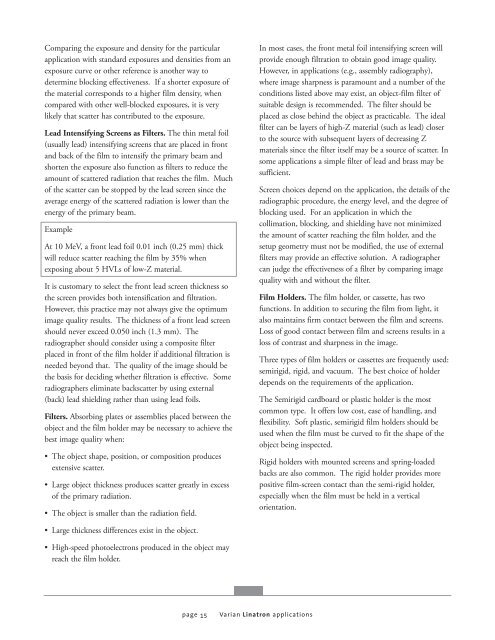





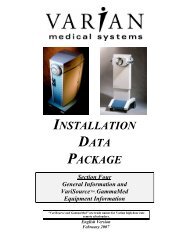

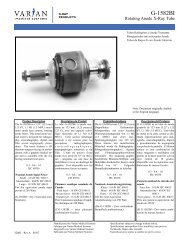
![[MSDS 126] Dow Corning 200 Fluid, 5 CST Part Number ... - Varian](https://img.yumpu.com/5104917/1/190x245/msds-126-dow-corning-200-fluid-5-cst-part-number-varian.jpg?quality=85)

